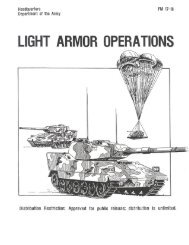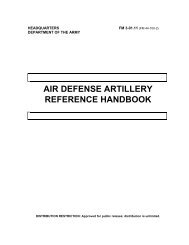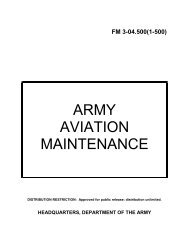fm 44-100 us army air and missile defense operations
fm 44-100 us army air and missile defense operations
fm 44-100 us army air and missile defense operations
You also want an ePaper? Increase the reach of your titles
YUMPU automatically turns print PDFs into web optimized ePapers that Google loves.
FM <strong>44</strong>-<strong>100</strong><br />
Win the Information War<br />
6-13. Timely information is of paramount importance to get the right force to<br />
the right place at the right time on the fast-paced, modern battlefield.<br />
Friendly forces m<strong>us</strong>t rapidly collect, process, <strong>and</strong> disseminate information to<br />
permit combat units to operate in depth <strong>and</strong> maintain initiative, agility, <strong>and</strong><br />
synchronization. The force's dependence on the prompt flow of information<br />
makes battle comm<strong>and</strong> centers prime targets for enemy <strong>air</strong> <strong>and</strong> <strong>missile</strong> <strong>operations</strong>.<br />
Therefore, the protection of battle comm<strong>and</strong> nodes is a key objective<br />
of <strong>air</strong> <strong>and</strong> <strong>missile</strong> <strong>defense</strong> <strong>operations</strong>. Denial of RSTA data to the enemy is<br />
equally important. By cutting the link between enemy comm<strong>and</strong>ers <strong>and</strong> their<br />
eyes, ADA forces the enemy to operate in the blind, to be reactive to US operational<br />
initiatives, <strong>and</strong> to lose offensive potential. In short, denial of RSTA<br />
data increases the probability of success of friendly <strong>operations</strong> <strong>and</strong> saves<br />
lives.<br />
6-14. Information <strong>operations</strong> (IO) involve actions taken to affect adversary information<br />
<strong>and</strong> information technology systems while defending one's own information<br />
<strong>and</strong> information systems. They apply across all phases of an operation,<br />
the range of military <strong>operations</strong>, <strong>and</strong> at every level of war. Information<br />
<strong>operations</strong> capitalize on the growing sophistication, connectivity, <strong>and</strong> reliance<br />
on information technology. IO targets information or information systems in<br />
order to affect the information dependent process, whether human or automated.<br />
Such information dependent processes range from national comm<strong>and</strong><br />
authorities-level decision making to the automated control of key commercial<br />
infrastructures such as telecommunications <strong>and</strong> electric power.<br />
6-15. Many different capabilities <strong>and</strong> activities m<strong>us</strong>t be integrated to achieve<br />
a coherent IO strategy. Intelligence <strong>and</strong> communications support is critical to<br />
conducting offensive <strong>and</strong> defensive IO. These assigned <strong>and</strong> supporting capabilities<br />
<strong>and</strong> activities include <strong>operations</strong> security (OPSEC), military deception,<br />
psychological <strong>operations</strong>, electronic warfare (EW), physical attack <strong>and</strong><br />
destruction, <strong>and</strong> may include computer network attack. Joint Publication 3-<br />
13 should be consulted for more information.<br />
Right Force at the Right Place at the Right Time<br />
6-16. The ADA comm<strong>and</strong>er has a number of different systems <strong>and</strong> task force<br />
organizations that can be employed. In each operation, the comm<strong>and</strong>er tailors<br />
the ADA force to match the factors of METT-TC. ADA is deployed<br />
throughout the depth of the battlefield, but the ADA comm<strong>and</strong>er ensures that<br />
ADA is where it is needed <strong>and</strong> can make the biggest impact on <strong>operations</strong>.<br />
Taking advantage of the mobility of ADA systems, the comm<strong>and</strong>er employs<br />
the force at the critical time <strong>and</strong> place.<br />
S<strong>us</strong>tain the Battle<br />
6-17. To s<strong>us</strong>tain the battle <strong>and</strong> the force's ability to maneuver, ADA systems<br />
engaged in <strong>air</strong> <strong>and</strong> <strong>missile</strong> <strong>defense</strong> <strong>operations</strong> m<strong>us</strong>t protect vital assets <strong>and</strong><br />
forces that perform s<strong>us</strong>tainment functions. These include lines of communications,<br />
fixed <strong>and</strong> mobile facilities, <strong>and</strong> organizations that support the force in<br />
deep, close, <strong>and</strong> rear <strong>operations</strong>. In the forward areas of the battlefield, ADA<br />
protects combat trains, refueling, <strong>and</strong> rearming <strong>operations</strong>. Air <strong>and</strong> <strong>missile</strong><br />
<strong>defense</strong> of rear s<strong>us</strong>tainment facilities concentrates on POL, ammunition, <strong>and</strong><br />
6-4











